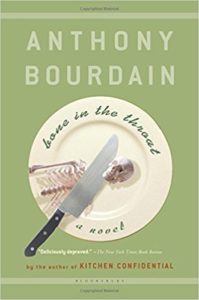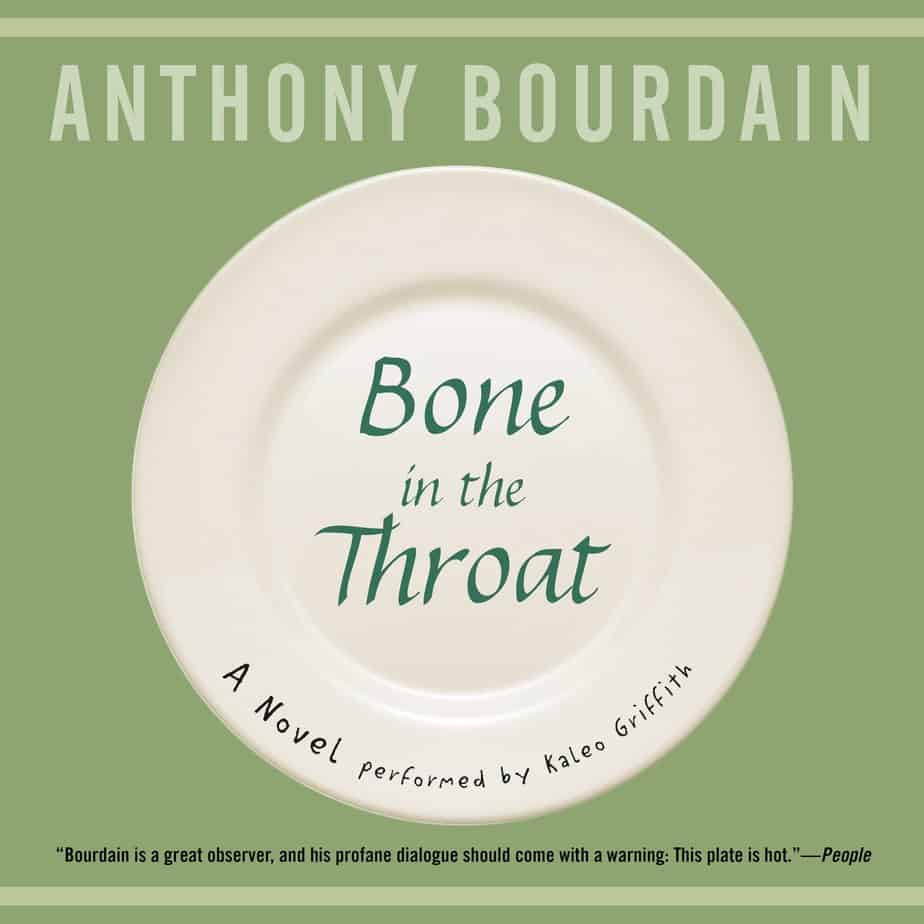 Anthony Bourdain described himself as a child being irresistibly drawn to the headiness of fresh, raw oysters in France. As a young man he was lured to the restaurant kitchen, to the love of food, and the thrills of the unsavory truths of working in food service. Throughout Kitchen Confidential, he admits his attraction to the dark and risky, to drugs and drinking, and to a life spent in restaurants and at bar tables. In that memoir, Anthony Bourdain invited us on a ride through “the culinary underbelly” of the kitchens, freezers, and back alleys of New York City restaurants.
Anthony Bourdain described himself as a child being irresistibly drawn to the headiness of fresh, raw oysters in France. As a young man he was lured to the restaurant kitchen, to the love of food, and the thrills of the unsavory truths of working in food service. Throughout Kitchen Confidential, he admits his attraction to the dark and risky, to drugs and drinking, and to a life spent in restaurants and at bar tables. In that memoir, Anthony Bourdain invited us on a ride through “the culinary underbelly” of the kitchens, freezers, and back alleys of New York City restaurants.
In 1973 Anthony Bourdain left his somewhat affluent home and a New Jersey private preparatory school for college. Vassar – an elite, selective all-women’s college – had opened its doors to men in 1969, just four years before his arrival. Yet, after only two years there, Bourdain dropped out. He had already spent time in Provincetown as a restaurant dishwasher and he had high praise for that job, explaining that he had to learn to work with others, to be on time, and to treat his superiors with respect. It was a few years later, after he returned to school (graduating in 1978 from the Culinary Institute of America in Hyde Park) that he began moving up the line as cook, sous chef, and finally to running restaurants on his own. It was also in these intimate kitchen settings in the 1980s where he became addicted to heroin and cocaine.
After his death by suicide last week, Bourdain was sometimes described by his critics as the fool-mouthed loser, the swaggering rogue, or the lowlife addict. His fans, however, know him more as a man who rose above his addictions to free himself of drugs by the early 90s (Bourdain received at least five years of treatment from methadone clinics). It was around 1994 that a friend challenged Bourdain to write. Bourdain had been a bright student, one who was well-read and who had always found writing easy. And so, Bourdain wrote.
In 1995, his mystery thriller Bone in the Throat was published. The book, described as “deliciously depraved” by New York Times reviewer Marilyn Stasio, is extremely funny and very irreverent. A body washes up on a New Jersey beach after being dumped in the New York Harbor and Bourdain begins to introduce us to his characters – SoHo hipsters, Mafiosos, flirty women and very bad men. They reminded me of Carl Hiaasen’s losers – those hanging around the Everglades and the Florida Keys.
Bourdain followed his first novel with Gone Bamboo in 1979 and again mixed mayhem, assassins and lots of tequila in another murderous swill. He was disappointed with his novels’ lack of the mainstream success. Yet, both were reprinted in paperback editions and Bone in the Throat, with Bourdain as an executive producer, was made into a film. (It did, however, receive mixed reviews and the DVD of the movie does not seem to have been released. There’s no sign of it on Amazon or Netflix).
In 2000, when he was 44 years old and the executive chef at New York’s Brasserie Les Halles, Bourdain decided to write about the life as he knew it – the behind-the-scenes, more often seedy, always raw and steamy, restaurant scene. What began as an essay for The New York Press (a local free-rag) ended up in the very respectable New Yorker magazine as “Don’t Eat Before Reading This.” Soon after, the full-length version published as Kitchen Confidential hit the bookshelves. That book appealed mainly to those who worked behind the scenes and façade of the linen-tablecloth’d, maître-d’d front room of the finest (and not-so-finest) eating establishments around the world. But it also quickly gained fame and readers clamored for more. Bourdain followed with A Cook’s Tour, which included a television show produced in 2000 and 2001 and aired beginning in 2002. This deep dive into world food became a hit on the Food Network and his faithful viewers loved his honest, often humble, sometimes macho take on the world’s dining tables.
At 44, rugged, handsome and charismatic Bourdain had the country, and the world, hooked. Yet, he admits at this time he was working to make ends meet. He had been married to Nancy Putkoski for over twenty years, from his addict days through his first literary and television successes. Finally, it seemed that he had won over some of his earlier demons – those of feeling a failure and a fraud. Anthony Bourdain’s Les Halles Cookbook was published in 2004, followed by Nasty Bits (2006), No Reservations (2007), and Medium Raw (2010).
Bourdain’s respectful celebrity grew with 35 episodes of A Cook’s Tour (2002-2003), nine seasons and 142 episodes of No Reservations. By the time of his death by suicide on June 2018, Bourdain had written 13 books and he was the immensely successful journalist/celebrity/host of the CNN program, Parts Unknown in its 11th season. He was, however, twice divorced (although that second divorce had not been finalized).
After his death, the world focused on Bourdain’s critical acclaim and the crucial need to prevent other deaths by suicide. Yet, many readers’ questions will be answered in his books when he shared his passions and his demons. He was inspired by books and reading. He loved passionately, especially as a father. Yet, he often spoke of the darkness and loneliness in his life.
In Anna Karenina, Leo Tolstoy wrote that “Happy families are all alike; every unhappy family is unhappy in its own way.” In the introduction to one of his last books, Appetites: A Cookbook, Anthony Bourdain writes that “Tolstoy never spent any time with my happy family.” At the time of publication, Bourdain’s daughter was 8 years old and it might have been Bourdain’s happiest time. He had finally found fame, wealth, and at the same time, contentment with his wife and daughter and professional life. Bourdain traveled about 260 days a year, yet he always carved out a five-day respite every month to spend with his daughter. He writes, in that introduction, that he made major changes in his lifestyle when his daughter was born. He was no longer “the star in his own movie.”
Every talk show featuring Bourdain and every speech he wrote portrayed an honest, humble man who was accessible and approachable. He rarely turned down an interview or an opportunity to write the introduction to another cook’s book. By the age of 61, he seemed to have overcome the personal failures of his youth. I have huge respect for the man and it has saddened me that his demons still lurked below the surface of success. A history of good food, adventurous eating and honest philosophy in his books is what Bourdain has left behind for us.
Charlotte Canelli is the Director of the Morrill Memorial Library in Norwood, Massachusetts. Read Charlotte’s column in the June 21, 2018 edition of the Norwood Transcript and Bulletin.




